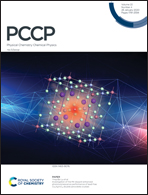Intramolecular mode coupling of the isotopomers of water: a non-scalar charge density-derived perspective†
Abstract
The H2O/D2O/HDO isotopomers of water are presented in terms that enable bond-flexing, bond-twist and bond-anharmonicity to be quantified during the bending (Q1), symmetric-stretch (Q2) and anti-symmetric-stretch (Q3) normal modes of vibration. Bond-flexing was detected by the presence of curved bonding and the bond-anharmonicity was detected by the presence of motion of the bond critical point (BCP) relative to the oxygen atom. These 2-D scalar measures are unable to fully describe the 3-D nature of the normal modes of vibration and therefore any susceptibility towards normal mode coupling, or to fully distinguish the three isotopomers. To detect bond-twist a vector-based measure was used, in the form of the bond critical point (BCP) trajectory, constructed in terms of preferred directions of electronic motion, defined by the variation of the position of the BCP during the normal modes of vibration. The BCP trajectories describe the coupling of the intramolecular bending and symmetric-stretch normal modes as well as distinguishing all three isotopomers within the harmonic approximation. The coupling of the bending and symmetric-stretch normal modes are suggested to be facilitated by the absence of bond-twist that would disrupt the coupling between Sigma O–H bonds and hydrogen-bonding. Partial coupling was found for the mixed isotopomer HDO.



 Please wait while we load your content...
Please wait while we load your content...